Fig. 4.1
(a) View of the virtual corridor used for navigation tasks under study; and (b) floor plan, and a sample of the route for one of the runs. The subjects were instructed to reproduce (e.g., retrieval) the previously shown routes (e.g., encoding) via navigating through virtual corridor by the joystick and to find the target location. It should be noted that starting position was the same for all runs
Assessment of “Sense of Presence” and Success Rate
All subjects were requested to report the illusion of forward self-motion and the sense of presence during VR navigation following the completion of this test similar to Jancke et al. [41]. It should be noted that sense of presence is understood to refer to the subjective feeling of being in a virtual environment while being unaware of one’s real location and surroundings as well as the technology that delivers the stream of virtual input to the senses [42]. Subjects were instructed to rate the strength of presence on a scale ranged from 0 (no presence) to 10 (very strong presence), similar to Witmer and Singer [43].
The task performance success rate was assessed combining three variables: (1) accuracy of the task performance (find vs. not find presented route during encoding phase); (2) number of trials needed to successfully complete the test (total allowed n = 3); and (3) time needed to complete the test (30 s maximal allowed). These three data sets were used as an input for normalized reports of success rate ranges from 10 to 0 for each subject under study. It should be noted, we were able to detect spatial memory abnormalities in concussed individuals in subacute phase of injury, although diagnosed as asymptomatic based upon conventional neurocognitive assessment tools [44]. Current research is in progress to evaluate both convergent and discriminant validity of VR spatial memory module in the context of concussion evaluation that will be published elsewhere.
VR Recognition “A” Test
This test aimed to measure a subject’s visual recognition performance in remembering and recognizing objects found within a virtual environment. This module can be used in conjunction with the recognition B test (see below). The subject’s task is to passively navigate through the virtual corridor. Along his/her way there are seven objects that should be memorized. Both types and color of these objects are important to remember. Then, the subject is presented with a display panel of 14 different objects and given 120 s to select only the same seven objects previously seen in the virtual corridor. The number of correct/incorrect responses and time to perform the test are computed and converted into the scoring format from 10 to 0 (Fig. 4.2).
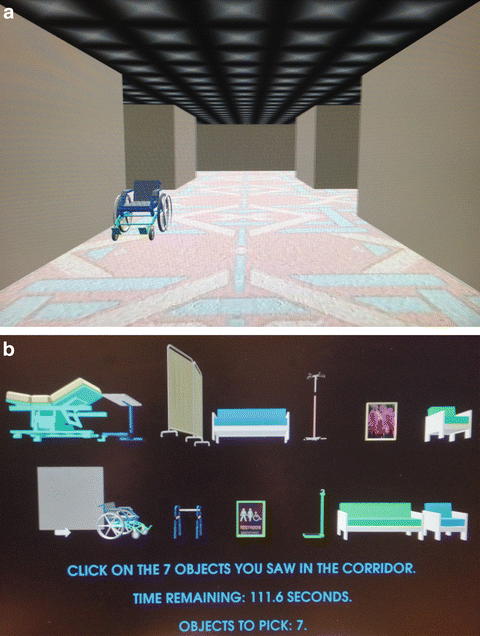

Fig. 4.2
(a) Different objects (total n = 7) are displayed to memorize while passively navigating via virtual corridor; (b) fourteen objects are displayed to recognize that were shown while navigating via virtual corridor
VR Recognition “B” Test
The subject is shown seven different objects slowly rotating for 60 s to memorize before passive navigation through the virtual corridor. Both the type and color of the objects are important memorizing properties. The subject is then passively navigated through the virtual corridor. If the subject recognizes an object from the seven objects previously shown in the display panel, he/she must press the trigger/button on the interactive device to select the recognized object. The total number of correct/incorrect responses is computed and converted into the scoring format from 10 to 0.
VR Assessment of Sustained Attention
Sohlberg and Matter in 1989 [45] proposed a clinical model of attention processes that outlined hierarchically organized levels of attention. Our personal experience in dealing with TBI patients on a daily basis is clearly in support of this clinical model of attention. Specifically, TBI patients, especially in acute stage of injury, most often are unable to sustain attention even for a short period of time. Their distractibility level increases significantly, affecting both everyday life and academic/learning activities. The rate of recovery of this cognition function is influenced by numerous factors, such as the initial impact, degree of structural damage, and/or initial functional deficits, although not well documented in clinical research.
The attention deficit in TBI, specifically deficits in visual selective and sustained attention, is a prominent aspect of cognitive dysfunction after TBI. TBI patients frequently complain of distractibility and difficulty attending to more than one thing at a time. We designed the VR prototype of Everyday Attention [46] within the context of a dual–task paradigm to assess attention deficits in mild TBI. Our design of the VR attention module, Virtual Elevator (VE), was implemented by HeadRehab, LLC and is currently utilized in our laboratory for baseline and follow-up testing of concussed athletes (Fig. 4.3).
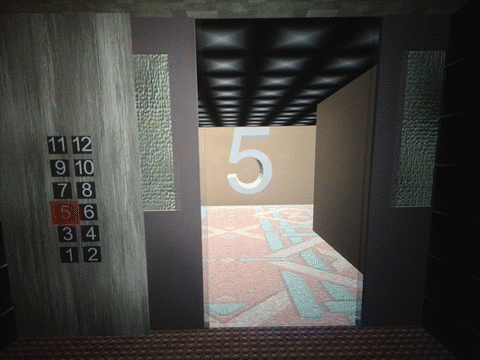

Fig. 4.3
The image of the Virtual Elevator module as perceived by the subject
The VR advanced prototype of the Test of Everyday Attention (TEA) using the Virtual Elevator was implemented as the following:
Sustained attention is being tested similar to the “Elevator Counting” test (1). The subjects are situated in the Virtual Elevator (VE) moving up (from floor 1 to floor 12) and down (from floor 12 to floor 1). There are visual separations that a subject should count in order to identify the floor indicator upon arrival (stop). There are numerous random trials that last for 10 min. The number of correct and incorrect counts assessed is used as an input to the comprehensive report.
Elevator floor counting with distractions. Similar to (A) while additional sources of noise (external visual stimuli, i.e., adjacent buildings, windows, trees, people coming in and out, etc.) are being added.
Dual-task version of VE is also elaborated to test the properties of “Divided Attention.”
These data were used as an input for normalized reports of success rate ranges from 10 to 0 for each subject under study. It should be noted, we were able to detect attention deficits in concussed individuals in subacute phase of injury, although diagnosed as asymptomatic based upon conventional neurocognitive assessment tools, such as STROOP, SDMT, WMS-R Digit Span, Ruff 2 s and 7 s Selective Attention Test, and PASAT [44]. Current research is in progress to evaluate both convergent and discriminant validity of VR sustained attention module in the context of concussion evaluation that will be published elsewhere.
VR Assessment of Balance
Balance abnormalities specifically evident during visual-kinesthetic tasks are the most common symptoms in TBI patients suffering from sport-related concussions [18]. It should be noted that balance symptom resolution varies among mTBI patients and may last up to more than 1 year post-injury [10]. Our previous research has shown the presence of balance abnormalities and visual-kinesthetic disintegration, induced by VR visual field motion up to 30 days post-injury [29–31]. We have designed the VR moving room paradigm to examine postural stability via introducing the visual perturbation balance tasks [29]. The VR moving room appears to be an advanced tool allowing the detection of residual postural abnormalities as evidenced by impaired visual-kinesthetic integration [10].
The VR system that was used in this study includes: (a) VisMini portable stereo 3D projection system; (b) Draper Inc. 6 × 8 portable Cinefold surface screen; and (c) AMTI force plate for assessment of postural responses to visual field motion.
The field sequential stereo images were separated into right and left eye images using liquid crystal shutter glasses. An additional sensor was located on the subject’s head to interact with the visual field motion. The visual field motion consists of a realistic looking moving room (see Fig. 4.4).
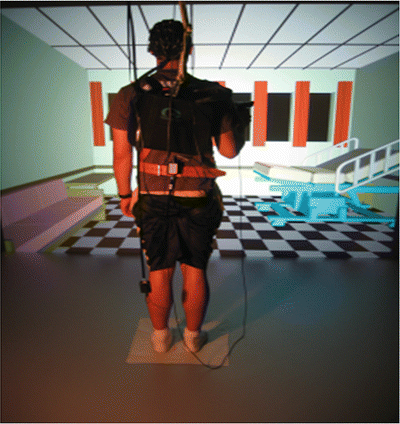

Fig. 4.4
AMTI force platform and 6° of freedoms ultrasound IS-900 micromotion tracking technology from “InterSense, Inc.” was used to control the head and body kinematics and postural responses to visual manipulations of VR scenes
Preprogrammed manipulations of the VR moving room included the following: (1) viewing stationary VR room; (2) VR room forward–backward oscillatory translation within 18 cm displacement at 0.2 Hz; (3) VR room Roll around heading y-axis between 10 and 30° at 0.2 Hz; (4) VR room Pitch around interaural x-axis between 10 and 30° at 0.2 Hz; (5) VR room Yaw around vertical z-axis between 10 and 30° at 0.2Hz; and (6) VR room translation along x-axis within 18 cm displacement at 0.2 Hz. The subjects were instructed: (a) to acquire the Romberg stance and stand as still as possible on the force platform while viewing the computer-generated moving room visual scenes for 30 s trial duration (VR—balance 1 test); and (b) to produce whole body oscillations in synchrony with the motion of the VR room along x, y, and z axes (VR—balance 2 test).
Normalized Assessment of Postural Stability
The area of the center of pressure (COP) was calculated from AMTI force platform data sampled at 100 Hz. A specially developed MATLAB program was used to estimate the subject response data obtained from the force platform similar to Slobounov et al. [36]. The COP area calculated from the data obtained for each individual subject (with respect to 450 records from normal age-matched volunteers) was used as an input for normalized reports of success rate (stable vs. unstable posture) ranges from 10 to 0 (loss of balance during the test).
Coherence values between quantities of moving room and subject responses were assessed using a specially developed MATLAB code. The auto-spectra for each signal were calculated by using Welsh’s averaged periodogram method. Coherence was calculated based on the cross-spectra fxy and auto-spectra fxx, fyy with the spectra estimated from segments of data and the coherence Rxy estimated from the combined spectra:


(4.1)
The significance of coherence was also calculated. That is the confidence limit for zero coherence at the α %, and L, is the number of disjoint segments: sig (α) = 1−(1−α)1/(L−1). In addition, continuous wavelet transform (CWT) was performed to track the dynamics of coupling between subject body motion and visual scenes oscillation over the entire trial duration (30 s). The CWT is able to resolve both time and scale (frequency) events better than the short Fourier transform (STFT). In mathematics and signal processing, the CWT of a function f is defined by (1):

where τ represents translation, s represents scale which is related to frequency, and ψ is the mother wavelet.  is the complex conjugate of z. The mother wavelet is a complex Morlet wavelet, as it has both good time and frequency accuracy. The degree of coherence was converted to normalized score ranged from 10 (max dynamic balance) to 0 similar to Slobounov et al. [30, 36].
is the complex conjugate of z. The mother wavelet is a complex Morlet wavelet, as it has both good time and frequency accuracy. The degree of coherence was converted to normalized score ranged from 10 (max dynamic balance) to 0 similar to Slobounov et al. [30, 36].

(4.2)
 is the complex conjugate of z. The mother wavelet is a complex Morlet wavelet, as it has both good time and frequency accuracy. The degree of coherence was converted to normalized score ranged from 10 (max dynamic balance) to 0 similar to Slobounov et al. [30, 36].
is the complex conjugate of z. The mother wavelet is a complex Morlet wavelet, as it has both good time and frequency accuracy. The degree of coherence was converted to normalized score ranged from 10 (max dynamic balance) to 0 similar to Slobounov et al. [30, 36].VR Assessment of Executive Function (Reaction Time)
Early and most recent research indicates that reaction time (RT), especially complex reaction time, significantly and reliably increased in mild TBI patients at least in acute phase of injury [13, 47–49]. Specifically, these finding have been replicated and confirmed in a number of studies [8, 50, 51]. Overall, it is widely accepted now that RT measures may serve as an index of the subject’s integrity of executive functions, therefore may be used in clinical assessment of concussion [8, 13, 50] (Fig. 4.5).
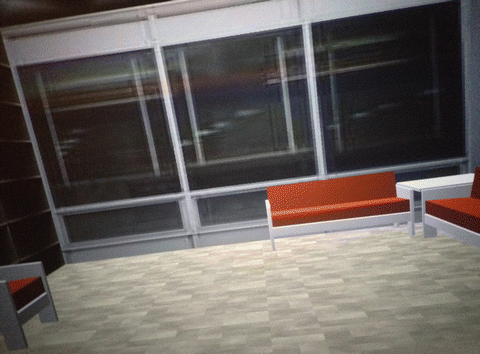

Fig. 4.5
Virtual room rolling to the left requiring subject to change direction of sway from AP to the left (ML) as fast as possible
We have designed a VR module of reaction time allowing the assessment of whole body response to unpredictable manipulation of optic flow. The subject was requested to oscillate forward and backward to follow the anterior–posterior (A–P) translation of the moving room at 0.2 Hz for 30 s trial duration.
Unpredictable change of moving room from A–P to medial–lateral (M–L) directions was randomized requiring the subject to respond via whole body motion and follow the motion of the moving room. The measured reaction time (ranged from 250 to 750 plus ms) and errors of anticipation (wrong direction of response) were calculated, interpolated, and converted into scoring system from 10 (best score, less than 250 ms compared to 450 samples from normal student-athletes volunteers) to 0 (more than 800 ms) and included in comprehensive reports. Current research is in progress to evaluate both convergent and discriminant validity of VR reaction time module with respect to RTclin and RTcomp derived from CogState-Sport [13] in the context of concussion evaluation that will be published elsewhere.
Experimental Procedure: Effect of Practice
Subjects: Data were collected from 15 athletically active and neurologically normal undergraduate students recruited from the Pennsylvania State University. Average age was 21.4 years (SD = 1.3) and average estimated IQ, based upon Wechsler Test of Adult Reading (WTAR; The Psychological Corporation, 2001) test scores, was 108.9 (SD = 6.4). The sample was 70 % male and 30 % female. The reported racial/ethnic composition was 70 % Caucasian American, 10 % African American, 10 % Asian American, and 10 % mixed. Overall, subject percentages can be presented as 10 % multiples, given the usable sample consisted of 10 subjects. All participants had become involved in sports between ages 4 and 8 years old and had maintained their involvement, at either the recreational or collegiate level, as students at the university.
All participants were right-handed [52], and none were taking medications known to affect neurocognitive measurements. We ensured that participants were neurologically normal through a telephone screening questionnaire. Participants were excluded if they reported a prior history of (a) TBI, (b) learning disability or attention deficit hyperactivity disorder, (c) alcohol or drug abuse or dependence, (d) a neurological condition, or (e) a psychiatric disorder. Participants were also excluded if English was not their first language. All participants reported that they had slept 7–8 h the night before testing. Half of the subjects were tested between 10:00 am and noon, and the other half was tested between noon and 2:00 pm. Subjects were requested to avoid taking any beverages containing caffeine at least 3 h prior to testing.
Procedures: Subjects were visiting our lab every other day for a total of three visits and performed sequence of (a) VR spatial memory navigation; (b) VR sustained attention; and (c) VR recognition, A and B; (d) VR balance tests; and (e) reaction time (RT). The order of testing modalities was randomized and necessary time between modalities was provided if needed to control for subjects’ fatigue. The total time of testing was within 45 min.
Statistical analysis: Two-way within-subjects ANOVA was performed to assess the score differences between testing modalities (n = 3) as a function of testing day (n = 3). The threshold level of significance was set at p < 0.05.
Experimental Procedure: Effect of Fatigue Induced by Full Contact Football Practices
Subjects: Fifteen Penn State football players participated in this study. The subjects were males whose mean age was 20 ± 1.6 years. At the time of this study none of the subjects were injured and all were cleared for full contact sport participation by the team physician. Complete medical history of all players under study was available only to one of the authors (Dr. Sebastianelli). The other members of the research team did not have access to the subjects’ medical records, thus were blind regarding the history of prior concussions until the completion of all results analysis.
VR assessment of spatial memory, balance, and executive functions (RT) was conducted prior to and within 30 min post-full contact practices. The number of blows during the practice was measured via reconstruction of impacts captured on video [53]. In addition, our research assistants registered the frequency and various types of impact experienced by the targeted players using a specially developed observation chart. The similar pre–post-full contact practice VR assessment was conducted 1 week later at the peak of preseason training load.
Results
Sense of Presence and Subjective Reports
All subject reports indicated that navigation via immersive VR environment induced a strong sense of presence. The scores for sense of presence for the spatial memory task were 6.8 ± 2.4, for the sustained attention task were 7.4 ± 1.7, and for the balance task were 9.2 ± 1.4. All subjects under study reported significant amounts of mental effort during the encoding phase of spatial memory task (8 ± 2) and during the retrieval phase (6 ± 2), that is consistent with our previous research [34, 54].
Effect of Practice
Representative example of VR data obtained for three consequent testing sessions of one subject is shown in Fig. 4.6.
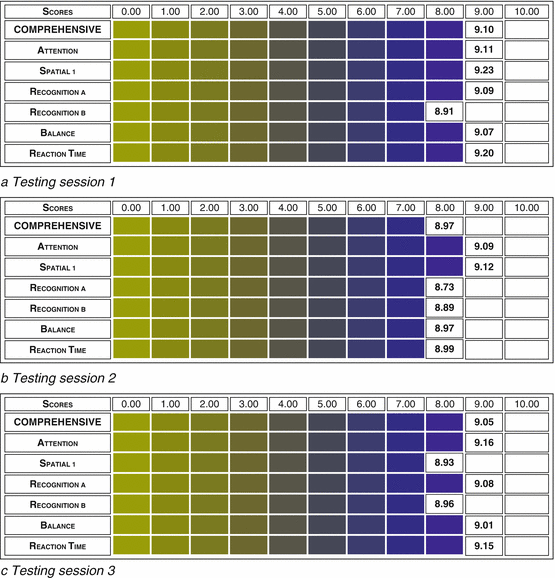

Fig. 4.6
Representative example from one subject on VR performance scores, including comprehensive, and those obtained from different testing modalities. Both visually and statistically there are no significant differences in performance scores as a function of testing day (n = 3)
The overall VR results obtained from all 15 subjects on three testing sessions are shown in Fig. 4.7.
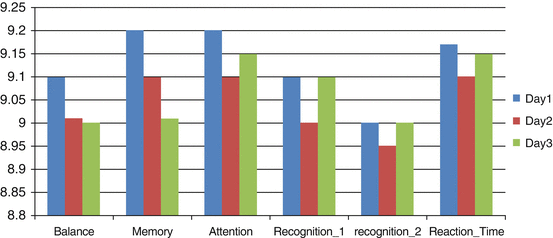

Fig. 4.7




Summary results of VR testing from all subjects under study (n = 15) as a function of testing day (n = 3). Both visually and statistically, no significant differences were observed within the testing modality and between tests indicating the lack of practice effect
Stay updated, free articles. Join our Telegram channel

Full access? Get Clinical Tree




